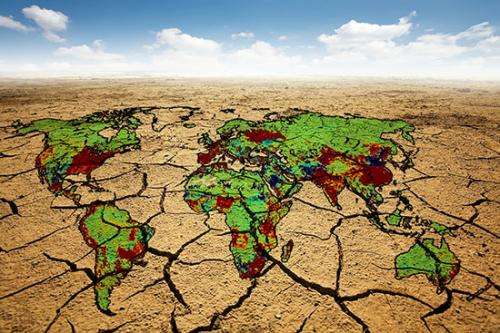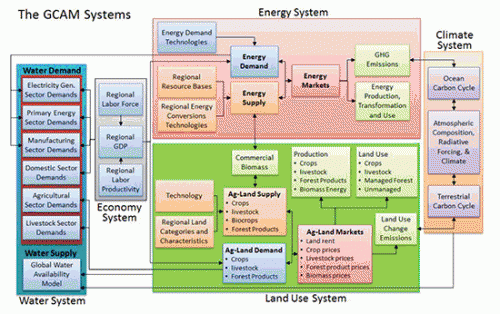Water scarcity and climate change through 2095

What will a global water scarcity map look like in 2095? Radically different, according to scientists at Pacific Northwest National Laboratory, depending on the type and the stringency of the climate mitigation policies chosen to reduce carbon pollution.
In a first of its kind comprehensive analysis, the researchers, working at the Joint Global Change Research Institute, used a unique modeling capability that links economic, energy, land-use and climate systems to show the effects of global change on water scarcity. When they incorporated water use and availability in this powerful engine and ran scenarios of possible climate mitigation policy targets, they found that without any climate policy to curb carbon emissions, half the world will be living under extreme water scarcity. Some climate mitigation policies, such as increasing growth of water-hungry biofuels, may exacerbate water scarcity.
Water scarcity may pose a significant challenge to our ability to adapt to or mitigate climate change. Why? For example, growing bioenergy crops to replace fossil fuel sources, an important component of many technology strategies that reduce greenhouse gas emissions, rely on plentiful water. Thus, water availability could impose severe limits on both emissions mitigation and climate adaptation.
PNNL enhanced the Global Change Assessment Model (GCAM) to assess the impact of changing water supplies and demands that stem from a simultaneously evolving human population, economic system, technology and climate.
"All high-resolution global integrated assessment models lack any representation of water systems," said Dr. Mohamad Hejazi, lead author and climate scientist at PNNL, working at the Joint Global Change Research Institute. "This implicitly assumes that emissions mitigation to climate change will be unaffected by water scarcity. Yet, we found that water is a significant component of our climate's future, even if societies deploy mitigation policies."

The team constructed a new gridded water-balance global hydrologic model and added the component to the GCAM water system. Combined with high-resolution (spatially downscaled) representations of all the existing water demand sectors in GCAM, this produced a dynamic, high-resolution view of global, annual water scarcity. They modeled six major water demand sectors (irrigation, livestock, domestic, electricity generation, mining, and manufacturing) in GCAM at multiple regional scales and then spatially downscaled. Further, they simulated six policy scenarios (two types and three targets of radiative forcings) in GCAM to estimate the impacts on water scarcity. Simulating these scenarios in GCAM allowed the researchers to quantify, in an integrated framework, the effects of climate mitigation policies on global and regional water scarcity estimates, while accounting for uncertainty arising from using different general circulation models and following different types and constraining levels of climate policies on water scarcity.
When compared to a baseline scenario where no climate policy is implemented, water scarcity declines under a universal carbon tax mitigation policy, but it increases with a fossil fuel and industrial emissions carbon tax mitigation scenario by the year 2095, mainly due to variations in prevailing bioenergy productions. The analyses show the baseline scenario results in more than half of the world's population living under extreme water scarcity by the end of the 21st century. By one measure (grid scale) in 2050, 36 percent of the global population will have greater water demands than water available in a year; and by 2095, that number increases to 44 percent. They also performed the calculations at watershed scale to complement the grid scale results.
More information: Hejazi M, J Edmonds, L Clarke, P Kyle, E Davies, V Chaturvedi, M Wise, P Patel, J Eom, and K Calvin. 2014. "Integrated Assessment of Global Water Scarcity over the 21st Century: Global Water Supply and Demand under Extreme Radiative Forcing." Hydrology and Earth System Sciences 18:2859-2883. DOI: 10.5194/hess-18-2859-2014.
Provided by Pacific Northwest National Laboratory















